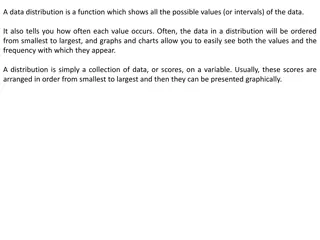Physical Distribution
Physical distribution is a critical aspect of business operations involving the planning, implementation, and control of the flow of goods from origin to consumer. Philip Kotler and William J. Stanton have defined physical distribution as a process of managing the movement of goods to meet consumer needs profitably. The objectives of physical distribution include consumer satisfaction, profit maximization, cost reduction, and competitive advantage. By optimizing physical distribution activities, businesses can enhance consumer satisfaction, reduce costs, stabilize prices, and improve overall customer service.
Download Presentation

Please find below an Image/Link to download the presentation.
The content on the website is provided AS IS for your information and personal use only. It may not be sold, licensed, or shared on other websites without obtaining consent from the author.If you encounter any issues during the download, it is possible that the publisher has removed the file from their server.
You are allowed to download the files provided on this website for personal or commercial use, subject to the condition that they are used lawfully. All files are the property of their respective owners.
The content on the website is provided AS IS for your information and personal use only. It may not be sold, licensed, or shared on other websites without obtaining consent from the author.
E N D
Presentation Transcript
Philip Kotler has defined physical distribution as, Physical distribution involves planning, implementing and controlling the physical flow of materials and final goods from the point of origin of use to meet consumer needs at a profit. According to William J. Stanton, Physical distribution involves the management of physical flow of products and establishment and operation of flow systems. Physical distribution is thus, management of the physical flow of products and management and operation of the flow system. It is a process of managing the movement of the goods.
Objectives of Physical Distribution: Physical distribution has two broad objectives viz. consumer satisfaction and profit maximisation. A satisfied consumer is the biggest asset that a company has. A firm can provide satisfaction to consumers by making available right quantity of right goods at right place and time, at lowest costs. Prompt and dependable distribution enhances consumer satisfaction. At the same time, by offering better service at lower price of the product, the firm can attract additional consumers and make more profits. This can be done by improving the efficiency and effectiveness of physical distribution activities, firm can bring in economy which will have an effect on profit margin
other objectives i. To make available the right goods in right quantity at right time and right place at least cost. ii. To achieve minimum inventory level and speedier transportation. iii. To establish price of products by effective management of physical distribution activities. iv. To gain competitive advantage over rivals by performing customer service more effectively. Its importance can be judged from following points: 1. Creating Time and Place Utility: Physical distribution activities help in creating time and place utility. This is done through transportation and warehousing. Transportation system creates place utility as it makes available the goods at the right place where they are required. Warehousing creates time utility by storing the goods and releasing them when they are required.
2. Helps in Reducing Distribution Cost: Physical distribution cost account for a major part of the price of the product. If these costs are handled systematically, decrease in costs of product can be there. Proper and systematic planning of transportation schedules and routes, warehousing location and operation, material handling, order processing, etc. can easily bring in cost economies. 3. Helps in Stabilisation of Price: Physical distribution helps in maintaining stable prices. Even customers expect price stability over a period of time. Proper use of transportation and warehousing facilities can help in matching demand with supply and thus ensure stabilisation of price. 4. Improved Consumer Services: Consumer service in physical distribution means making products in right quantity available at right time and right place i.e. place where customer needs.
Components of Physical Distribution: (1) Order Processing: Order processing is the starting point of any distribution activity. Order processing includes activities like receiving the order, handling the order, granting credit, invoicing, dispatching, collecting bills, etc. Each customer expects that the order placed by him is implemented without delay, and as per the specifications of the order. 2) Storage and Warehousing: Storage means making proper arrangements for retaining the goods in proper condition till they are demanded by customers. There are many products which are seasonally produced but are used throughout the year, they can be stored and later released. Similarly, there are products which are produced throughout the year but are seasonally used like umbrella, fans, heaters, etc. Here also storing plays an important role. Storage reduces the need for instant transportation which is difficult and costly.
3) Inventory Control: Inventory control refers to efficient control of goods stored in warehouses. Maintaining adequate level of inventory is very essential for smooth flow of business. Inventory acts as a bridge between the orders of customers and production. They are the reservoir of the goods held in anticipation of sales. Therefore, it needs to be properly managed and controlled. Neither to small nor too large inventory should be maintained. (4) Material Handling: Material handling includes all those activities which are associated in moving products when it leaves the manufacturing plant but before it is loaded on the transport. This activity has been in existence since very long period of time, and now it has developed as a system. It involves moving the goods from plant to warehouses and from warehouses to place of loading in transport modes. Proper management of material handling helps in avoiding unnecessary movement of goods, avoiding damage to the goods, facilitate order processing and efficient movement of goods.
5) Transportation: Transportation as a component of physical distribution is concerned with the movement of goods from the warehouse to customer destination. It includes loading and unloading of goods and their movement from one place to another. In doing so it provides time and place utility. Transport accounts for a major portion of the distribution cost and of the total price of the product.























